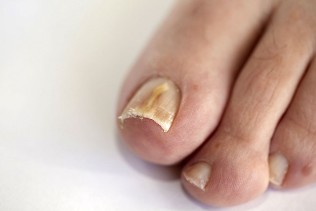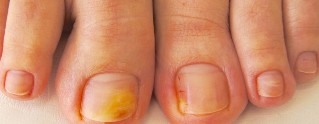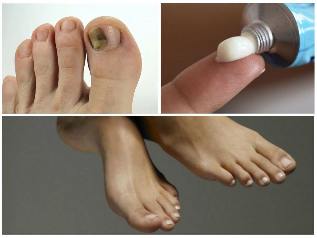Onychomycosis or fungal nails is a nasty disease, difficult-to-treat. The disease develops when the fungus gets under the nail plate or skin around the nail. Pathogenic micro-organisms eat the keratin, as a result, its amount is quickly decreased, and the nail is destroyed.

The causes of the disease and the ways of infection
The fungus affects the nail plate, is propagated in a humid environment with high temperature. Infected with fungus can when you visit public places, such as the climate. Most often the fungus "lives" in the public showers, gyms and swimming pools. Often the infection occurs when visiting the beach. Another way infection is close contact with a carrier of infection. Developing the disease is also possible using the personal belongings of sick people.
However, in order to obtain nail fungus, the mere touch of the agent on the skin is not enough. A strong immune system to effectively suppress the pathogenic microflora and does not develop lesions in the nail plates. Predisposing factors for the development of the fungus on the nails are:
- reduced immunity, both General and local;
- violation of blood circulation in the lower extremities;
- excessive sweating of the feet;
- wearing mismatched shoes that violate the bloodstream;
- the damage and injury of the skin on the feet.
The rapid growth of pathogenic organisms is often observed in the blood circulation, causing a number of diseases and metabolic disorders. To provoke the disease can also be the wrong shoes, wearing which increases the sweating and the disturbed blood flow. A favorable environment for pathogenic microflora is wet to the skin, which does not get enough oxygen. It happened when a man wears socks of synthetic fabrics and narrow shoes, made of faux "not breathing" materials.
Another reason, which can trigger the development of infection is disregard for the rules of hygiene and not following safety measures. Patients can accidentally "" mushroom – try someone else's shoes, visiting the public pool or shower without Slippers, or use someone else's towel for the feet.
Often people make a serious mistake when buying a new pair of shoes – they're trying to her bare feet did not wear socks. Such action can cause nail fungus, because it is not known which was measured in the same shoes in the past, and will not, whether on foot infected with pathogenic microflora.
How to recognize the disease?
When nail fungus on the feet, the symptoms are so typical that confuse this disease with other diseases, is very difficult. In order to identify pathology, it is necessary to know its main features, including:

- the formation of spots and stripes under the nail plate;
- white muddy color of the nail.
- inflammation and dryness of the skin around the finger to the affected nail;
- plaque mold;
- fragility and change the structure of the nail plate.
The first symptom of the disease is the formation of streaks or spots of a greenish or yellowish color. These tapes went deep into the thickness of the nail plate and gives the impression that they are the skin under the nail.
Usually primarily affects the big toes, at least – the little finger. The initial stage of the disease is the fungus only shows the color changes of the nail plate and the characteristic spots and stripes. After some time, the infection affects the fingers, redness, flaking and itching, the skin around the nails.
Treatment of the disease at this stage, you can effectively and quickly get rid of the fungus, however, patients rarely seek help from a doctor, without noticing similar symptoms.
Growth of the population of pathogenic microflora, the fungus begins to destroy the surface of the nail plate. It is characterized by the fact that the nail becomes soft and wavy, it cracks and depressions, the structure is heterogeneous. This can be accompanied by pus under the nail and a sharp unpleasant odor from the feet. Over time, the nail is destroyed, peeling to enhance and affect the skin between the toes.
It seems that the loss of the nail depends on the mushroom. The causative agent of the disease is often the yeast or fungal spores. During infection yeast nail plate acquires a gray-bluish color. The nail is quickly destroyed, and as a result completely different from the nail bed.
Mold fungi affect the nail plate, if it's a violation of nutrition of tissues, for example, as a result of strong compression of the nails too tight shoes. This type of onychomycosis is characterized by the formation of whitish coating on the nails.
Knowing how the disease, it is important to visit your doctor. Different fungi have different symptoms and treatment that is difficult to guess, on their own, without consulting a specialist.
The principle of treatment
Treatment damage to the nail plate requires a holistic approach and takes a long time. It is important to remember that the quicker the symptoms of the fungus and start treatment, the faster you can get rid of the disease.
To combat the disease are used:

- antifungal creams and solutions;
- systemic antifungals tablets;
- traditional medicines.
To fix the pathology of the early stages of using an external antifungals. Such preparations include ointments, solutions, as well as stop the antifungal components in the composition.
The treatment most often prescribed a cream broad-spectrum components that actively affect a variety of fungi, such as yeast. Ointments and creams are better to use early stages of the disease. Violation of the structure of the nail plate, they are ineffective, because the components of the drug can penetrate into small cracks in the nail.
The most effective are antifungal drugs solutions. Such drugs are usually made of bubbles with a pipette. The product is applied to the nail plate. Thanks to the liquid consistency, the substance meets the slightest wrong behavior and get under the nail plate, thereby effectively functioning to the affected area.
Pharmacies are widely represented products in the form of varnish. The peculiarity of this form of antifungal drugs is that they do not need to use every day. Varnish is applied every few days. Pharmaceutical form a protective coating on the nail plate, which protects the nail and prevents the spread of fungal infection. The active substance of the drug to penetrate the nail plate and work for a long time – one application is sufficient for antifungal activity throughout the two days. Coatings are also effective in the prevention of fungal diseases. You can use them once a week or apply it before visiting places with high risk of infection by the fungus.
In addition, processing of the nail plate, it is necessary to adjust the antifungal protection of the skin around the nail and between the toes. To do this, use the ointment.
If the nails have started to break down, preparations for external use is not enough, so in addition to the name of the antifungal pill. These chemicals have a systemic effect on the entire body.
If the fungus nail is accompanied by a bacterial infection, with the appearance of pus, in addition to the amount of creams, which have an antibacterial effect, for example, Levomekol.
In folk medicine used the following remedies against onychomycosis.

- Mix apple cider vinegar and water applied with a gauze compress, which is applied to the affected nail for 1 hour. The procedure is repeated daily for two weeks.
- Squeeze the juice of one lemon and mix with two tablespoons of water. The solution should be used for the treatment of the affected nails twice a day.
- Foot bath, add two large spoons of baking soda and iodized or sea salt. The feet are put in the bath for half an hour. The procedure is performed every day before going to bed.
Further treatment of the nails with the juice of onion or propolis tincture. Folk remedies, it is recommended to use in conjunction with antifungal medications that are prescribed by a doctor.
The most difficult stage of the fungal infection leads to the loss of the nails, so it is important to promptly contact a specialist as soon as the first symptoms of the disease.





























